

Telos LRF Manual
Content
Specifications
About the device
Description
Package Contents
Components and Controls
Features
Power supply
Precautions
Recommendations for Battery Use
Battery Charging
Battery Installation
External Power Supply
Getting Started
Powering on and Image Settings
Installation of the 3-point strap on the carrying case
Button Operation
Interface
Status Bar
Quick Menu
Main Menu
Enter the Main Menu
Amplification Level
Colour Modes
Smoothing Filter
User Mode
Display Settings
PiP Mode
Wi-Fi Settings
Microphone Rangefinder
Calibration Mode
General Settings
Defective Pixel Repair
Defective Pixel Repair
Restore Default Pixel Map
Device Information
Functions
Video Recording and Photography
Laser Rangefinder
Digital Zoom
PiP Function
Display-Off Function
Wi-Fi Function
Installing the Device on a Tripod
USB Connection
Software
Stream Vision 2
Firmware Update
Maintenance
Technical Inspection
Technical Maintenance and Storage
Troubleshooting
Legal Compliances and Disclaimers
Specifications
You can learn more about the main parameters here.
Eyepiece Focus Range, Dioptre +4 / -5
Detection Distance for DeerSized Objects, m/y 1300 / 1422
Display
Resolution,
Operational
Video Recorder
Photo/Video Resolution, Pixels 1024x768
Video/Photo Format .mp4 / .jpg
Built-in
Wi-Fi
Wavelength, nm 905
Measurement Range, m/y*** 1000/1094
Measurement Accuracy, m 1
* Actual operating time depends on the extent of using Wi-Fi, integrated video recorder and integrated laser rangefinder.
** Reception range may vary depending on various factors: obstacles, other Wi-Fi networks.
*** Depends on the characteristics of the object under observation and environmental conditions.
Operational
Power Supply, V 3 - 4.2
Battery
Li-ion Battery Pack / 6400 mAh / DC 3.7 V
V, 9 V (USB Type-C)
Video Recorder
Photo/Video Resolution, Pixels 1024x768
Video/Photo Format .mp4 / .jpg Built-in Memory 64 GB Wi-Fi
* Actual operating time depends on the extent of using Wi-Fi, integrated video recorder and integrated laser rangefinder.
** Reception range may vary depending on various factors: obstacles, other
Wi-Fi networks.
*** Depends on the characteristics of the object under observation and environmental conditions.
Battery
- 4.2
Li-ion Battery Pack / 6400 mAh / DC 3.7 V
V, 9 V (USB Type-C)
+40 / -13 +104
Video Recorder
Photo/Video Resolution, Pixels 1024x768
Video/Photo Format .mp4 / .jpg
Built-in Memory 64 GB
Wi-Fi Channel**
2.4/5 GHz Standard IEEE 802.11 b/g/n/ac
Characteristics
Measurement
m 1
* Actual operating time depends on the extent of using Wi-Fi, integrated video recorder and integrated laser rangefinder.
** Reception range may vary depending on various factors: obstacles, other Wi-Fi networks.
*** Depends on the characteristics of the object under observation and
environmental conditions.
https://www.youtube.com/embed/nkkHTeKZCDw
Telos LRF thermal imaging monoculars are designed for use both at nighttime and during the day and provide exceptional image quality even in adverse weather conditions (fog, smog, rain) and beyond obstacles like branches, tall grass, dense foliage, etc. known to hinder target detection.
Unlike night-vision devices based on electron-optical converters, thermal imaging devices do not need an external light source and are resistant to bright light.
Telos LRF thermal imagers are designed for various applications including hunting, observation, security, terrain orientation, search and rescue operations, etc.
Telos LRF thermal imagers are equipped with a built-in laser rangefinder with a range of up to 1000 m and a measurement accuracy of ± 1 m.
To get started, see the sections:
Battery Charging
Battery Installation
Powering on and Image Setting
Laser Rangefinder
Stream Vision 2
Package Contents
Telos LRF thermal imager
LPS7i battery pack with protective cover
Spare battery compartment cover
Power adapter
USB Type-C cable with USB Type-A adapter
Case
Hand strap
Quick start guide
Lens cloth
Warranty card
Components and Controls

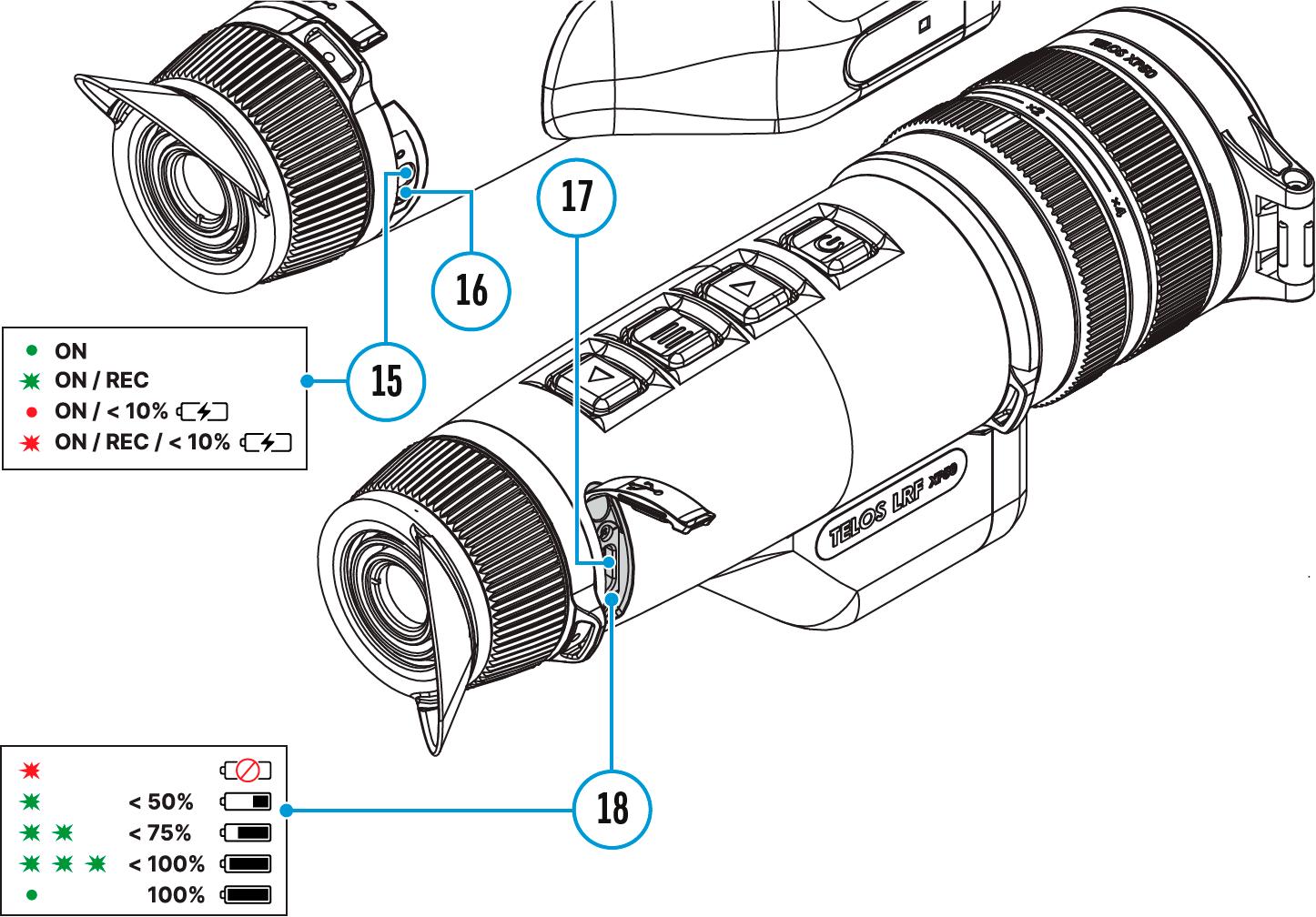
1. Lens cover
2. Laser rangefinder
3. Lens focus ring
4. Digital zoom adjustment ring
5. Battery compartment
6. LPS7i battery 7. Battery compartment cover 8. Battery protective cover 9. ON/OFF/Calibration button 10. UP/REC button 11. MENU button 12. DOWN/LRF button 13. Eyepiece diopter adjustment ring 14. Tripod adapter (available separately) 15. Operation status LED indication 16. Microphone 17. USB Type-C connector 18. LED indication of battery charge in the deviceLED indicator (15) displays the current status of the device:
LED Indicator Operating Mode




Device is turned on
The device is turned on/video recording
The device is turned on/battery charge < 10%
The device is turned on/video recording/battery charge < 10%
Features
Functional and ergonomic design
8-colour display palette
3 calibration modes: Manual, Semi-Automatic, Automatic
Detection range up to 1800 m/1969 yds
Smooth digital zoom 2.5-10x
Three levels of sensitivity enhancement: Normal, High, Ultra
Integrated laser rangefinder
Display-Off function
Display dimming function
Auto shutdown function
Device firmware update using the free Stream Vision 2 App
Defective pixel repair
Wide operating temperature range (-25° to +40° / -13°F to +104°F)
Fully waterproof (IPX7 rated)
Video/Audio Recording
Built-in video and sound recorder
Integration with iOS and Android devices
Wi-Fi remote control and viewing using a smartphone
Storing photos and videos in Cloud when using the Stream Vision 2 App
Battery Pack
Quick Change Li-Ion Battery Pack LPS7i
Charging from USB Power Bank
Quick-Charge power delivery
Precautions
It is not recommended to charge the battery with the USB cable and wireless charger at the same time. This will not increase the charge rate and may damage the battery.
Use the USB Type-C cable and power adapter supplied with the device (or purchased separately) to charge the LPS 7i batteries.
Follow the safety precautions described in its Manual when using the wireless charger.
Do not place any foreign objects between the battery and wireless charger platform.
Do not charge the battery immediately after bringing it from cold to warm. Wait at least 30 minutes for the battery to warm up.
Do not leave the battery unattended while charging.
Do not use the power adapter and wireless charger if they have been modified or damaged.
Do not leave the battery plugged in after charging is complete.
Do not expose the battery to high temperatures and naked flame.
Do not use the battery as a power source for devices that do not support LPS 7i batteries.
Do not disassemble or deform the battery.
Do not drop or strike the battery.
Do not submerge the battery.
Keep the battery out of the reach of children.
Recommendations for Battery Use
The battery should be partially charged (50 to 80 %) for long-term storage.
Charge at an ambient temperature of 0°C to +35°C (32°F to 95°F) or the lifespan of the battery will decrease significantly.
Using the battery at sub 0°C (<32°F) ambient temperature decreases battery capacity. This is normal and not a defect.
Using the battery at temperatures outside the range of -25°C to +50°C (13°F to 122°F) may reduce battery life.
The battery is short-circuit protected. Any situation that may cause short-circuiting should be avoided.
Battery Charging
The Telos LRF thermal imager comes with an LPS7i rechargeable Lithiumion battery. LPS7i batteries support USB Power Delivery fast charging technology when using a standard charging set (USB Type-C cable, power adapter). Before first use, make sure the battery is fully charged. LPS 7i batteries also support wireless charging.

The icon in the status bar will flash when the battery is low. The battery needs to be charged.
Option 1.USB Charging
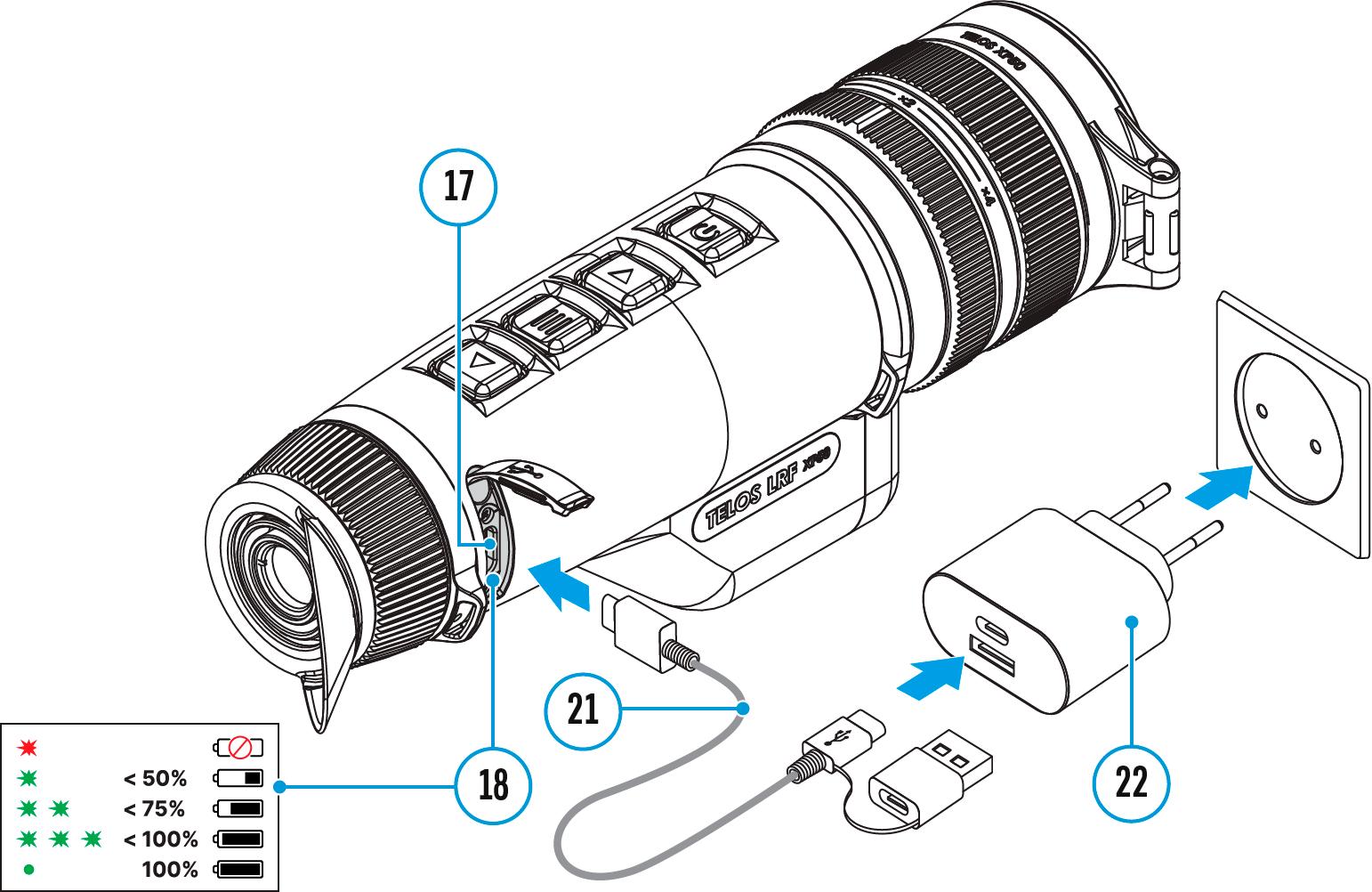
1. Install the LPS7i battery in the battery compartment of the device.
2. Connect the USB cable (21) to the USB Type-C connector (17) of the device.
3. Connect the other end of the USB cable (21) to the Power Adapter (22) by removing the USB Type-A adapter.
4. Plug the Power Adapter (22) into a 100-240 V socket.
5. Wait until the battery is fully charged (indication in the status bar: Image not found or type unknown ).


If the device is off, the LED indicator (18) will display the battery charge status:
LED indication




Battery charge status
Battery defective. Do not use the battery!
Battery charge level is from 0% to 50%
Battery charge level is from 51% to 75%




Option 2.Charging the battery via USB
Battery charge level is from 76% to 99%
Battery is full


2. Connect the plug of the USB Type-C cable (21) to the USB Type-C connector (19) of the battery.
3. For fast charging, connect the second end of the USB Type-C cable (21) to the Type-C connector of the power adapter (22) by removing the Type-A adapter from the plug. When connected to a computer or a Type-A power adapter, the battery will charge at normal speed.
4. Plug the power adapter (22) into a 100-240 V socket.
5. LED (20) will display battery charge level (see Table).
LED indication








Option 3.WirelessCharging
Battery charge status
Battery defective. Do not use the battery!
Battery charge level is from 0% to 50%
Battery charge level is from 51% to 75%
Battery charge level is from 76% to 99%
Battery is full
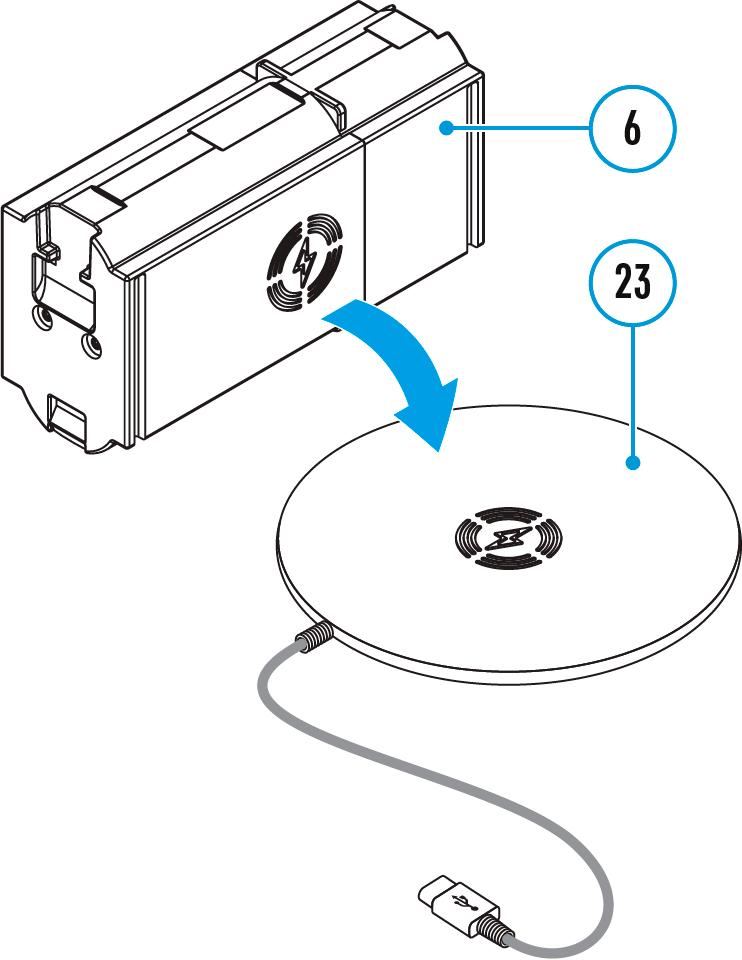

1. Place the battery (6) with the sign side on the wireless charger* (23). For more efficient wireless charging, align the lightning bolt icon on the battery with the centre of the charger platform (23).
2. Turn on the wireless charger according to its instruction manual.
3. LED (20) will display battery charge level (see Table).
* Third party-purchasing. The LPS7i battery works with all QI standard wireless chargers.
Note: Charging with a USB cable is significantly faster than using a wireless charger.
Battery Installation
1. Install the cover (7) on the LPS7i battery (6).

2. Insert the battery (6) into the battery compartment (5) until you hear a click. The battery contacts must face the top of the device (see diagram).

 3. To remove the battery (6), slide the switch (A) on the cover (7) to the left .
3. To remove the battery (6), slide the switch (A) on the cover (7) to the left .
External Power Supply
Show device diagram


Power can be supplied from an external source such as a 5 V or 9 V power bank.
1. Connect the external power source to the USB Type-C connector (17) on the device.
2. The device will switch to draw power from the external source while the LPS7i battery is gradually recharged.

3. A battery icon will appear on the display showing the percentage-charged level.

4. An icon will be displayed when the device is powered by an external power source and the LPS7i battery is not connected.
5. The device automatically switches to the LPS7i battery when the external power supply is disconnected.
Attention! Charging LPS7i batteries from an external source at temperatures below 0°C (<32°F) can reduce battery life. When using external power, connect the power bank to the device only after it has been turned on and working (warming) for at least several minutes.
Powering on and Image Settings
Show device diagram


1. Open the lens cover (1)
2. Press the ON/OFF (9) button briefly to turn on the device.
3. Adjust the eyepiece diopter ring (13) until the symbols in the display are sharp.
4. Rotate the lens focus ring (3) to focus on the object being observed.
5. To change the magnification, turn the digital zoom adjustment ring (4).
6. Enter the main menu with a long press of the MENU (11) button and select the desired calibration mode: manual (M), semi-automatic (SA) or automatic (A).
7. Calibrate the image by briefly pressing the ON/OFF (9) button (if the SA or M calibration mode has been selected). Close the lens cover when calibrating manually.
8. Activate the quick menu by briefly pressing theMENU (11) button to adjust the brightness and contrast of the display and select the desired amplification level ( Normal , High , Ultra ) (for more details see the Quick Menu section).




9. Activate the smoothing filter in the main menu to improve the image as the amplification level increases.
10. Select one of the colour palettes in the main menu (for more details see the Colour Modes section).
11. Upon completion of use turn the device off by a long press of the ON/OFF (9) button.
Observation conditions: time of day, weather, type of observation objects affect the image quality. Custom settings for brightness, display contrast as well as the function of adjusting the microbolometer sensitivity amplification level will help to achieve the desired quality in a particular situation.
Warning! Never point the lens at intensive energy sources such as laser radiation emitting devices or the sun. It can damage electronic components in the device. The warranty does not cover damage arising from failure to comply with operating instructions.
Adjusting the position of the hand strap

Installation of the 3-point strap on the carrying case
The carrying case comes with 3-point-strap for comfortable carrying of the case on the chest during intensive movement.

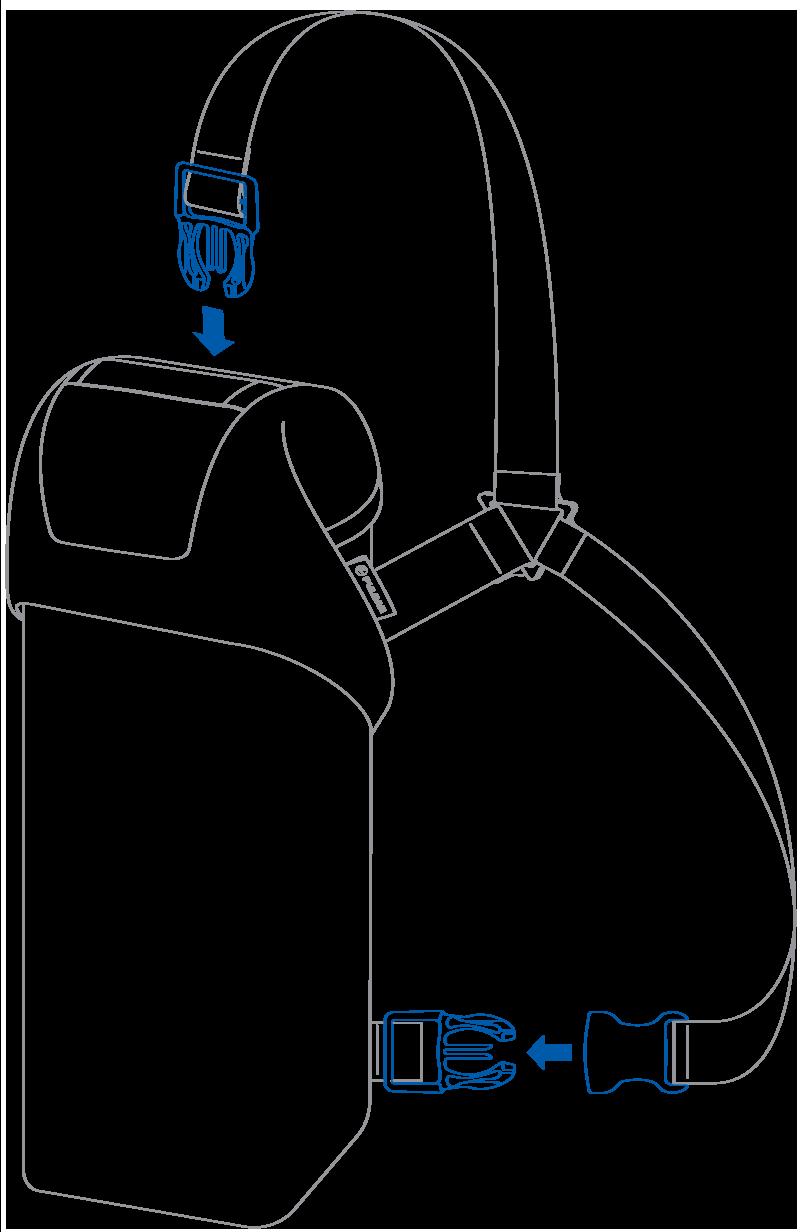

Button Operation
Operation Button

Power device on short press

Power device off long press for 3 secs

Turn display o long press for less than 3 secs

Turn display on short press

Calibrate the microbolometer short press

Turn on/off the White Hot palette long press
Video Recorder Button

Start/pause/resume video recording short press

Stop video recording long press

Switch to video / photo long press

Capture a photo short press
Laser Rangefinder Button

Turn on rangefinder short press

Single distance measurement short press

Activate rangefinder scan mode long press

Deactivate rangefinder scan mode short press

Turn off rangefinder long press
Main Menu Button

Enter main menu long press

Navigation upwards/rightwards short press

Navigation downwards/leftwards short press

Con rm selection short press

Exit submenu without con rming selection long press

Exit menu (switch to viewing mode) long press
Quick Menu Button

Enter quick menu short press

Switch between quick menu options short press

Increase value short press

Decrease value short press

Exit quick menu long press
Status Bar
The status bar at the bottom of the display shows current operating statuses via icons, including:
Colour Mode:

- White hot

- Black hot
Amplification level
Smoothing Filter (displayed when the function is on)
Calibration Mode (in Automatic calibration mode a countdown timer will appear instead of the calibration mode icon 5 seconds before automatic calibration begins).

Microphone
Magnification
Wi-Fi Connection
Time
Power Indication:

- charge level if the device is powered by a battery



- charge level if the device is charging and powered by a battery
- no battery, the device is connected to an external power supply
- low battery charge
Quick Menu
Show device diagram


The quick menu is used to quickly access the settings for brightness, contrast, and amplification modes.
Enter the menu by briefly pressing the MENU (11). A short press of the MENU (11) button enables you to toggle between functions, as described below.



Brightness press the UP (10)/DOWN (12) buttons to change display brightness from 0 to 20.

Contrast press the UP (10)/DOWN (12) buttons to change image contrast from 0 to 20.
Note:display brightness and contrast settings are saved in the memory when the device is turned off.

Amplification Levels allows you to select one of three amplifying levels of sensitivity(Normal , High , Ultra ).



Note: To maintain brightness and contrast settings when changing amplifying levels, activate User Mode
Press and hold the MENU (11) button to exit the menu or wait for 10 seconds to exit automatically.
Video Recording and Photography
Show device diagram


Telos LRFthermal imagers are capable of video recording and photography. Videos and images are saved on the built-in memory card.
Before using this feature please set the date and time (see General Settings section).
For information on how to watch recorded photos and videos, see the Stream Vision 2 user manual: Android, iOS
The built-in recorder operates in two modes Video and Photo.
Video mode. Video recording

1. Switch to Video mode by pressing and holding the UP/REC (10) button.

2. The icon and the remaining recording time in HH:MM (Hours:Minutes) format are displayed in the upper left corner, for example 4:20.
3. Press the UP/REC (10) button briefly to start video recording.

4. When the video recording starts, the icon will disappear and the REC icon and timer in MM:SS (Minutes:Seconds) format will appear


5. Pause and resume recording video with a short press of the UP/REC (10) button.
6. Stop recording video with a long press of the UP/REC (10)button.
7. Video files are saved to the built-in memory card after the video recording has been stopped.
8. Press and hold theUP/REC (10) button to switch between the Videoand Photomodes (Video-> Photo-> Video )
 Photo Mode. Capturing an image
Photo Mode. Capturing an image
1. Switch to the Photomode by pressing and holding the UP/REC (10) button.
2. Press the UP/REC (10) button briefly to take a photo. The icon flashes the photo file is being saved to the built-in SD card.

Notes:
You can enter and operate the menu during video recording.
Recorded videos and photos are saved to the internal memory card in the format img_xxx.jpg (photos), video_xxx.mp4 (videos).
Videos are recorded in clips with a maximum duration of 5 minutes. The number of recorded files is limited by the capacity of unit s internal memory and video compression ratio.
Regularly check the free capacity of the internal memory and move recorded footage to other storage media to free up space on the internal memory card.
In case of a memory card error, you can use the format function in the General Settings section of the main menu.
When the Display Off function is activated, video recording continues to run in the background.
Laser Rangefinder
Show device diagram


The TelosLRFthermal imager is equipped with an integrated laser rangefinder.
Single Measurement Mode
1. Press the ON/OFF (9) button briefly to power the device on.
2. Activate the rangefinder by pressing the DOWN/LRF (12) button briefly. A red mark appears on the display.
3. Place the rangefinder s reticle on the target. Press the DOWN/LRF (12) button briefly to measure the distance to the object once.
4. The measurement results are displayed in the upper right corner.
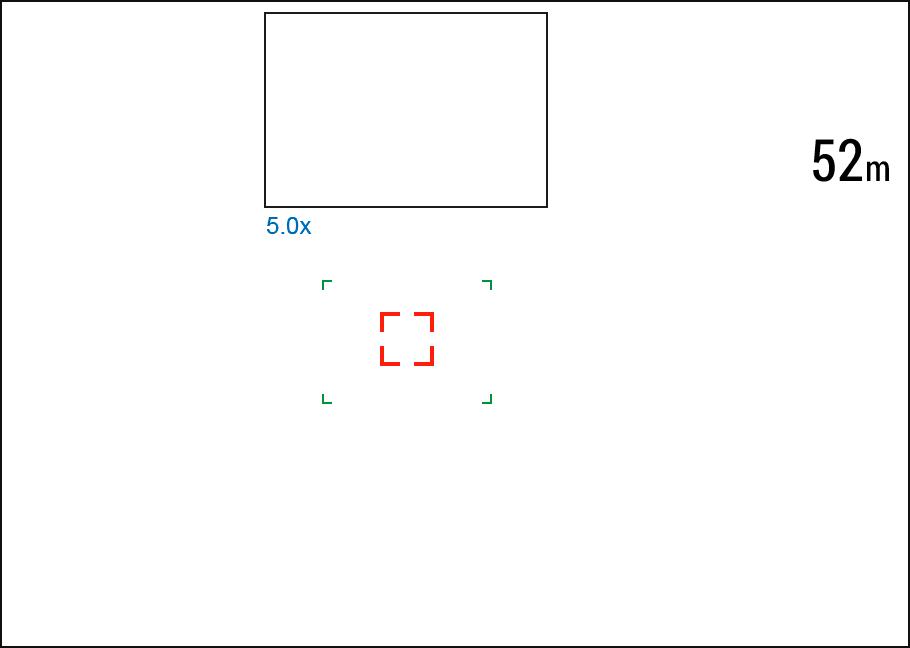
5. The rangefinder shuts down after 3 seconds of inactivity.
Scan Mode
1. Press the ON/OFF (9) button briefly to power the device on.
2. Activate the rangefinder by pressing the DOWN/LRF (12) button briefly. A red mark appears on the display.
3. Activate the scan mode by long pressing the DOWN/LRF (12) button to continuously measure the distance to objects.
4. The measurement results are displayed in the upper right corner.

5. Deactivate the rangefinder by long pressing the DOWN/LRF (12).
Notes:
Additional rangefinder settings are available in the Rangefindersection of the main menu.
To select a unit of measurement (meters or yards) go to Units of Measure subsection of the General Settings section.

When you turn on the rangefinder, the PiP window turns on.
Additional Information:
The accuracy and distance of the measurement depends on the reflection coefficient of the object surface and weather conditions. The reflection coefficient depends on the texture, colour, size and shape of the object. Generally, lighter coloured objects and those with a shiny surface will have a higher reflection coefficient.
Measurement accuracy can be influenced by the light conditions, fog, haze, rain, snow, etc. The results may be less accurate when operating in sunny weather or if the rangefinder is directed towards the sun. It is easier and more reliable to measure the distance to large objects than to small ones.
Digital Zoom
Show device diagram


The functionality of the device makes it possible to smoothly increase the base magnification (please refer to the Magnification line in the Specificationstable) of the device using the adjustment ring (4) , as well as return to the base magnification

To increase the digital zoom, turn the adjustment ring (4) clockwise.
To decrease the digital zoom, turn the adjustment ring (4) counterclockwise.
PiP Function
Show device diagram


The PiP (Picture-in-Picture) function allows you to see both the main image and a magnified image in a dedicated window.
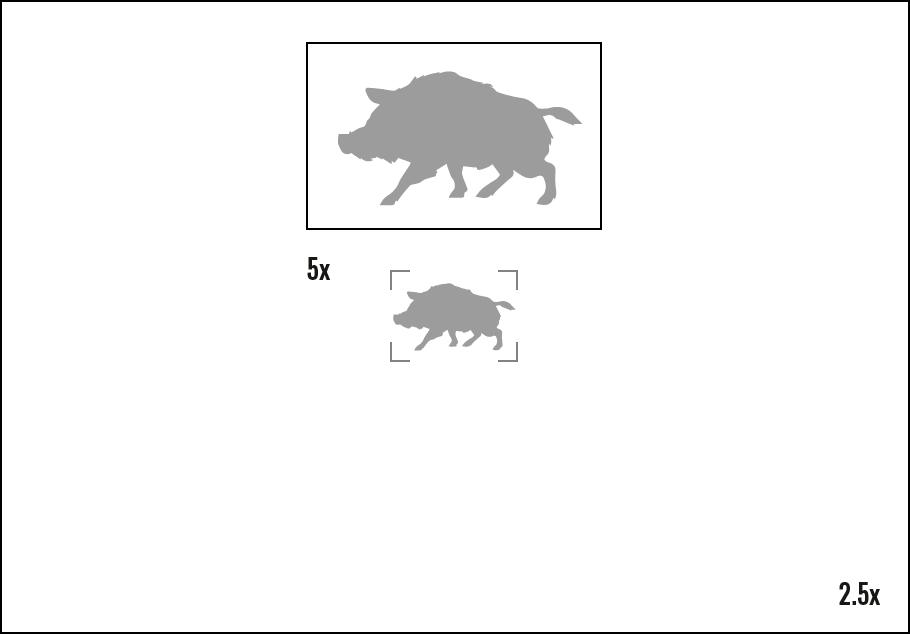
To turn on and off the PiP function see the PiP Mode section. Rotate the adjustment ring (4) to change the magnification ratio in the PiP
The zoomed image is displayed in a dedicated window, while the image
in the rest of the screen is displayed at base magnification (2.5x).
When the PiP is turned on you can control both the discrete and smooth digital zoom. In this case the zoom value changes only take place in the dedicated window.
When the PiP function is turned off, the screen will display at the magnification that was set in PiPmode.
Show device diagram


This function darkens the screen, which aids the user s concealment. However, the device stays on.
When this function is in use, the device switches to the standby mode, which allows it to be switched on instantly.

1. When the device is on, press and hold the ON/OFF (9) button. The display will turn off, the current time and the "Display off"icon will appear.
2. Turn the display back on with a short press of theON/OFF (9) button.
3. When you press and hold the ON/OFF (9) button, the display shows the "Display off" icon with a countdown. Pressing & holding the button down for the duration of the countdown will power the device off completely.
Wi-Fi Function
The device has a function enabling wireless communication with external devices (smartphone or tablet) via Wi-Fi.
Turn on the wireless module in the WI-Fi Activation menu option.
Wi-Fi is displayed in the status bar as follows:

Indication on the status bar Connection Status





Wi-Fi is switched off
Wi-Fi connection is in progress
Wi-Fi is switched on, no connection with device
Wi-Fi is switched on, device connected
The device is recognized by an external device as TELOS_XXXX where XXXX are the four last digits of the serial number. After entering the password (default: 12345678) on a mobile device (see Password Setup subsection of the Wi-Fi Settings section for more information on setting a password) and setting up a connection, the icon in the status bar will change to . The Wi-Fi function will turn off automatically if there is not enough battery power for Wi-Fi. The battery icon will turn red and flash. To use the Wi-Fi function again, you need to charge the battery.


Installing the Device on a Tripod

1. Screw the tripod adapter (14) (purchased separately) onto the tripod mounting plate until it stops.
2. Attach the mounting plate to the tripod.
3. Install the Telos LRF device into the tripod adapter (14) so that the rangefinder lens aligns with the hole on the front of the tripod adapter (14)
4. Turn the handle of the tripod adapter (14) to position .

5. Level the Telos LRF horizontally and vertically using the tripod mounting plate.
USB Connection
Show device diagram



1. Connect one end of the USB cable to the USB Type-C port (17) of your device and the other end to the USB port of your PC / laptop using a USB Type-A adapter.
2. Turn the device on with a short press of the ON/OFF(9) button (a device that has been turned off cannot be detected by your computer).
3. Your device will be detected by the computer automatically; no drivers need to be installed.
4. Two connection modes will appear on the display: Power and Memory Card(external storage device).
5. Select the connection mode with the UP (10)/DOWN (12) buttons.
6. Confirm the selection with a short press of the MENU (11) button.
Power
In this mode, a PC/laptop is used as an external power supply. The status bar shows the icon . The device continues operating and all functions are available.

Battery recharge feasibility depends on your computer's USB port.
When the USB is disconnected from the device when in the Power mode, the device keeps operating with the Battery Pack if it is available and sufficiently charged.
Memory Card (external memory)
In this mode the device is detected by the computer as a flash card. This mode is designed for work with the files saved in the device's memory.
The device's functions are not available in this mode; the device turns off automatically.
If video recording was in progress when the connection was made, recording stops and the video is saved.
If the device is in Memory Card mode and is disconnected from USB, the device will remain on.
Stream Vision 2

Install the Stream Vision 2 application to download files, update firmware, control the device by remote control and broadcast images from your device to a smartphone or a tablet via WiFi.
We recommend using the latest version Stream Vision 2.

You can find further guidelines on Stream Vision 2 here.
Download from Google Play
Download from App Store
Find answers to frequently asked questions about using Stream Vision 2 here.
Stream Vision 2 Manual
Firmware Update
1. Download the free Stream Vision 2 App in Google Play or App Store.
2. Connect your Pulsar device to your mobile device (smartphone or tablet).
3. Launch Stream Vision 2 and go to section Settings .
4. Select your Pulsar device and press Check firmware update .
5. Wait for the update to download and install. Pulsar device will reboot and will be ready to operate.
Important:
if your Pulsar device is connected to a phone or mobile device, please turn on mobile data transfer (GPRS/3G/4G) to download update; if your Pulsar device is not connected to your phone or mobile device but is already listed in Settings > My devices section, you may use Wi-Fi to download update.
Find answers to frequently asked questions about using Stream Vision 2 here.
Is your firmware up to date?
Click hereto check the latest firmware for your device.
Technical Inspection
It is recommended to inspect your device before each use. Check the following:
The device should be free of any cracks or deformations.
The lenses should be free of cracks, grease, dirt or debris.
The battery level of the device should be full. Electrical sockets should be free of salts, oxidation, or other debris.
All controls should be responsive.
Technical Maintenance and Storage
Maintenance should be carried out at least twice a year and should include the following steps:
Wipe the exterior surfaces of metal and plastic parts with a cotton cloth. Do not use chemically active substances, solvents, etc. as these will damage the paint.
Clean the electrical contacts of the rechargeable battery on the device using a non-greasy organic solvent.
Check lenses of objective, eyepiece and rangefinder. If necessary, remove dust and sand from the optics (it is preferable to use a noncontact method). Cleaning of the exterior surfaces of the optics should be done with cleaners designed especially for this purpose.
Store the device in a carrying case. Remove the Battery Pack for longterm storage.
Troubleshooting
For technical support please contact support@pulsar-vision.com.
Answers to frequently asked questions about the devices can also be found in the FAQ section.
The device does not turn on
Possible cause
The battery is completely discharged.
Solution
Charge the battery.
The device does not operate from an external power source
Possible cause
The USB cable is damaged.
Solution
Replace the USB cable.
Possible cause
The external power supply is discharged.
Solution
Charge the external power supply (if necessary).
The image is blurry, with vertical stripes or an uneven background
Possible cause
Calibration is required.
Solution
Perform image calibration according to the Calibration Mode section of the manual.
Black screen after calibration
Solution
If the image does not clear after calibration, you need to recalibrate.
Poor quality image. There is noise or ghost images of previous scenes or objects
Possible cause
Manual calibration has been performed with the lens cover open.
Solution
Check theCalibration Mode, close the lens cover and calibrate the device.
Image is too dark
Possible cause
Brightness or contrast level is too low.
Solution
Adjust the brightness or contrast level in the Quick Menu.
Colour bars appear on the display or the image disappears
Possible cause
The device was exposed to static charges during operation.
Solution
When the exposure to static charges is over, the device may either reboot automatically or require to be switched off and on again.
The image of the object being observed is missing
Possible cause
The object is behind glass, which obstructs thermal vision.
Solution
Remove the glass.
Poor image quality / Detection range reduced
Possible cause
These problems may occur during observation in adverse weather conditions (snow, rain, fog, etc.).
The image quality during the device operation at below zero temperatures is worse than at positive temperatures
Possible cause
In warm climates, objects in the background of a thermal image heat up differently because of thermal conductivity, generating a high temperature contrast and a sharper thermal image.
In cold climates, objects in the background of a thermal image will cool down to roughly the same temperature, which leads to a greatly reduced temperature contrast and a degraded image quality. This is normal for all thermal imaging devices.
Smartphone or tablet PC cannot be connected to the device
Possible cause
Device password has been changed.
Solution
Delete the network and connect again using the password saved in the device.
Possible cause
The device is in an area with too many Wi-Fi networks that may be causing signal interference.
Solution
To ensure a stable Wi-Fi connection, relocate the device to an area with fewer or no Wi-Fi networks.
Possible cause
The device has a 5 GHz network enabled, but the smartphone only supports 2.4 GHz.
Solution
Switch the device's Wi-Fi bandwidth to 2.4 GHz.
More information on solving problems with connection to Stream Vision 2 by following the link.
Wi-Fi signal is missing or interrupted
Possible cause
Smartphone or tablet is out of range of a strong Wi-Fi signal. There are obstacles between the device and the smartphone or tablet (e.g., concrete walls).
Solution
Relocate smartphone or tablet into the Wi-Fi signal line of sight.
More information on solving problems with connection to Stream Vision
2 by following the link.
Rangefinder does not measure distance
Possible cause
There is an object in front of the receiver or emitter lens preventing signal transmission.
Solution
Make sure that: the lenses are not blocked by your hand or fingers; the lenses are clean.
Possible cause
The device is not being held steadily when measuring.
Solution
Keep the device steady when measuring.
Possible cause
Distance to the object exceeds 1000 m.
Solution
Pick an object at a distance not longer than 1000m.
Possible cause
Low reflection ratio (i.e. leaves of trees).
Solution
Pick an object with higher reflection ratio (see point Additional Informationin section Laser Rangefinder).
Large measurement error
Possible cause
Inclement weather conditions (rain, mist, snow)
Legal Compliances and Disclaimers
Attention! A license is required for Telos Thermal Imager when exporting outside your country.
Electromagnetic compatibility.This product complies with the requirements of European standard EN 55032: 2015, Class A.
Warning!Operation of this equipment in a residential environment could cause radio interference.
Caution use of controls or adjustments or performance of procedures other than those specified herein may result in hazardous radiation exposure.

The manufacturer reserves the right at any time, without mandatory prior notice to the Customer, to make changes to the package contents (subject to the applicable laws, if any), design and characteristics that do not impair the quality of the Product.
Repair of the device is possible within 5 years.

